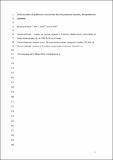Characterization of glutathione S-transferases from the pine wood nematode, Bursaphelenchus xylophilus
Abstract
We have previously identified two secreted glutathione S-transferases (GST) expressed in the pharyngeal gland cell of Bursaphelenchus xylophilus, which are upregulated post infection of the host. This study examines the functional role of GSTs in B. xylophilus biology. We analysed the expression profiles of all predicted GSTs in the genome and the results showed that they belong to kappa and cytosolic subfamilies and the majority are upregulated post infection of the host. A small percentage is potentially secreted and none is downregulated post infection of the host. One secreted protein was confirmed as a functional GST and is within a cluster that showed the highest expression fold change in infection. This enzyme has a protective activity that may involve host defences, namely in the presence of terpenoid compounds and peroxide products. These results suggest that GSTs secreted into the host participate in the detoxification of host-derived defence compounds and enable successful parasitism.
Citation
Espada , M , Jones , J T & Mota , M 2016 , ' Characterization of glutathione S-transferases from the pine wood nematode, Bursaphelenchus xylophilus ' , Nematology , vol. 18 , no. 6 , pp. 697-709 . https://doi.org/10.1163/15685411-00002985
Publication
Nematology
Status
Peer reviewed
ISSN
1388-5545Type
Journal article
Description
This work was supported by the EU 7th Framework REPHRAME project (KBBE.2010.1.4-09) and by FEDER Funds through the Operational Programme for Competitiveness Factors – COMPETE and National Funds through FCT – Foundation for Science and Technology under the Strategic Projects PEst-C/AGR/UI0115/2011 and PEst-OE/AGR/UI0115/2014. ME is funded by the FCT (Fundação para a Ciência e a Tecnologia, IP) under the PhD grant (SFRH/BD/84541/2012). The James Hutton Institute receives funding from the Scottish Government.Collections
Items in the St Andrews Research Repository are protected by copyright, with all rights reserved, unless otherwise indicated.

